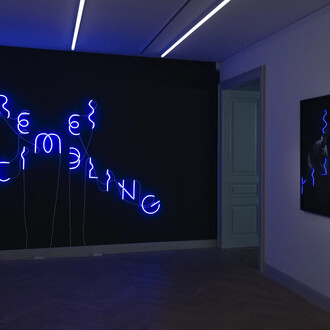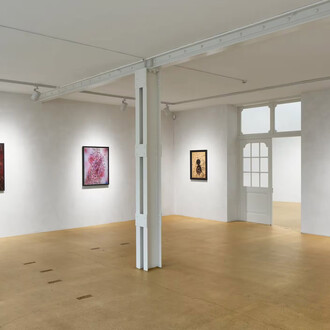Linda Fregni Nagler has been gathering images for years. Her work has always originated from these collections. The genesis of this exhibition, How to Look at a Camera, the third solo show at Galleria Monica De Cardenas, develops from a series of images showing blind people and figures seen from behind. The latter often remain enigmatic. A carte de visite that presented – or so it seemed – an upside-down flower, was quite mysterious at first. Instead, it was the body of a woman from Peru, a Tapada Limeña.
About ten pieces – the largest body of works in the exhibition – involve this subject, the veiled woman in Peru in the 19th century. Especially in Lima, women of rank could be seen in the street after the morning mass, or during a stroll at dusk, covered with garments that concealed their charms, protecting their privacy and anonymity. Their costume – the saya y manto – was of Andalusian origin. The evolution of its use transformed this raiment into a tool of seduction. Only a single eye could be seen of the entirely cloaked body, through the opening of the veil. With this eye, the tapada invented strategies to entice admirers. The foreign photographers who settled in Lima halfway through the 1800s were also fascinated – the Courret brothers or Eugène Maunoury, for example, both correspondents of the Nadar studio in Paris.
Posing in the studio, the tapada who peers into the camera is a cyclops facing a cyclops. The lens, in the end, is a synthesis of the two eyes that approach each other to the point of overlapping. The meaning of this exhibition lies in the economy of the gaze of these women. The attraction to the material aspect of photography and familiarity with its techniques have led Linda Fregni Nagler to experiment with the photogravure process, in a larger format than the original. The images are mechanically etched on a zinc plate which after treatment becomes the matrix for printing with a press. Various modes of offering or denying the gaze, the ritual character of posing in a photography studio, the awareness of being photographed, the way of looking from one eye only: these are the factors that emerge in the gathering of these images that Linda Fregni Nagler has collected and selected for translation into a new visual orchestration.
Linda Fregni Nagler (Stockholm, 1976) presented Things that Death Cannot Destroy at the Teatro dell’Arte of Triennale di Milano in 2019, work that began in 2009 and developed over the years as a single body of performative actions in various museums and institutions, including the Moderna Museet of Stockholm and Teatro Valle in Rome. In 2017 she curated the exhibition Hercule Florence. Le Nouveau Robinson at the Nouveau Musée National de Monaco. Winner of the ACACIA Prize in 2016, she was a finalist of the Premio MAXXI (Museo Nazionale delle Arti del XXI Secolo) in Rome in 2014. In 2013 she took part in the 55th Venice Biennale, Il Palazzo Enciclopedico, curated by Massimiliano Gioni, in a special section curated by Cindy Sherman. That same year MACK Books (London) published her monograph titled The Hidden Mother, based on the work shown at the Biennale. She has a degree from the Accademia di Belle Arti di Brera, Milan, where she teaches in the master program in photography.












